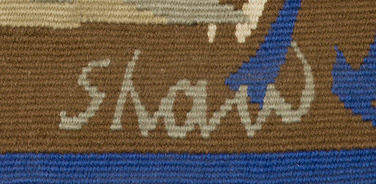The first part of this double-post looked at the inclusion of artist's signatures in tapestry designs and their subsequent weavings. This post will examine the inclusion of weavers' initials in Dovecot's practice.
Lord of the Hunt was the first tapestry to be completed at the studio, woven from 1912 to 1924 and interrupted by the First World War. It was the war that led to the poignant inclusion of the initials of master weavers John Glassbrook and Gordon Berry. Their initials are set behind a bobbin and shears on the lower border of the tapestry; not only do the commemorate the weavers, they mark the extent of weaving that had been achieved when war was declared.
| Detail of The Admirable Crichton, 1927-1930, designed by Alfred Priest, woven by David Lindsay Anderson, Ronald Cruickshank, Stanley Ebbutt and John Louttit. |
| Detail of The Admirable Crichton, 1927-1930, designed by Alfred Priest, woven by David Lindsay Anderson, Ronald Cruickshank, Stanley Ebbutt and John Louttit. |
Initials continued to be included on the front of tapestries up to 1939. The images above show the Head Weaver David Lindsay Anderson's initials on the lower border of The Admirable Crichton, with the weavers initials above the top border.
After the Second World War the practice remained the same, but at some point initials were moved to the back of tapestries. This was not a sudden change but happened gradually. The images below show the weavers' initials and Dovecot symbol (a subject for another blog post!) on the selvedge that is turned back on the tapestry.
As a researcher these initial serve a practical purpose. The archival information about Dovecot's history is patchy at best. Studio weavers are at risk of becoming anonymous if their names are not recorded in surviving archives or included on the physical tapestry. Some Dovecot tapestries do not include any initials!
In recent years the studio has been at pains to ensure that this does not happen in the future. There remain some projects that do not have an appropriate space for initials, such as quick, slow illustrated in the last post. However, in most cases it is possible, as in these small Peter Blake designed tapestries woven by Naomi Robertson - her initials are on the side of the mounts:







